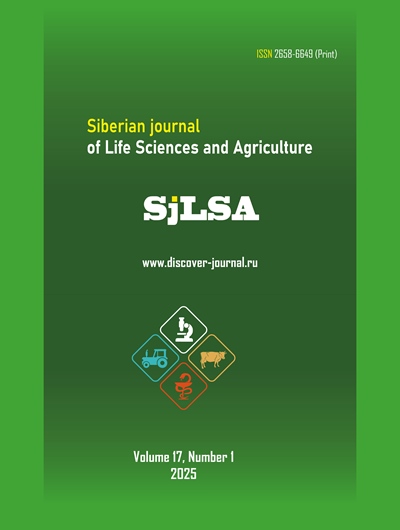Evaluation of Vitamins (A, C, D, E) Levels in Psoriasis Patients in Basrah, Iraq
Аннотация
Background. Psoriasis is a persistent inflammation that leads to an excessive growth of cells. Vitamins are crucial for maintaining the health of the skin.
Purpose. Study the relationship between vitamins and psoriasis.
Methods. A randomized clinical trial was carried out in Basrah , Iraq. Specimens were obtained from the Al-Faihaa Hospital and the Basrah Teaching Hospital. The analytical sample consisted of 45 individuals diagnosed with psoriasis and 45 persons who were in good condition. Their data were collected based on age, gender, disease severity, treatment, and geographical area, we conducted an analysis of the samples using several ELISA device measurements .
Results. The study revealed notable disparities in the levels of vitamin C and vitamin D, with statistically significant differences at a significance level of p<0.001. Additionally, there was a significant difference in the levels of vitamin E, with a significance level of p<0.01. The data did not indicate any variations in vitamin A levels, save for a discrepancy based on geographical location. The findings indicated a decline in vitamin E levels among male patients and a reduction in vitamin D levels among female patients. There is a positive relationship between the variables C, E and C, D. The results did not indicate any impact on the concentration of vitamins based on the severity of the condition and the method of treatment.
Conclusions. It is imperative to administer vitamins (C, D, and E) to individuals with psoriasis, in order to prevent the exacerbation of symptoms and the development of other ailments.
EDN: VPCOZS
Скачивания
Литература
Capon, F. (2017). The genetic basis of psoriasis. International Journal of Molecular Sciences, 18(12), 1–9. https://doi.org/10.3390/ijms18122526
Ran, D., Cai, M., & Zhang, X. (2019). Genetics of psoriasis: A basis for precision medicine. Precision Clinical Medicine, 2(2), 120–130. https://doi.org/10.1093/pcmedi/pbz011
Damiani, G., Bragazzi, N. L., Karimkhani Aksut, C., Wu, D., Alicandro, G., McGonagle, D., … Naghavi, M. (2021). The global, regional, and national burden of psoriasis: Results and insights from the Global Burden of Disease Study. Frontiers in Medicine, 8, 1–12. https://doi.org/10.3389/fmed.2021.743180
Griffiths, C. E. M., Armstrong, A. W., Gudjonsson, J. E., & Barker, J. N. W. N. (2021). Psoriasis. The Lancet, 397(10281), 1301–1315. https://doi.org/10.1016/s0140-6736(20)32549-6
Potestio, L., Lauletta, G., Tommasino, N., Portarapillo, A., Salsano, A., Battista, T., … Megna, M. (2024). Risk factors for psoriasis flares: A narrative review. Psoriasis (Auckland), 14, 39–50. https://doi.org/10.2147/PTT.S323281
Osigwe, P. C., Agomoh, C. E., Osigwe, I. S., & Akumiah, F. K. (2024). The association between psoriasis and atherosclerotic cardiovascular disease: A systematic review and meta-analysis of observational studies. Cureus, 16(6), 1–29. https://doi.org/10.7759/cureus.63379
Bellinato, F., Maurelli, M., Geat, D., Girolomoni, G., & Gisondi, P. (2024). Managing the patient with psoriasis and metabolic comorbidities. American Journal of Clinical Dermatology, 25(4), 527–540.
Dattola, A., Silvestri, M., Bennardo, L., Passante, M., Scali, E., Patruno, C., & Nisticò, S. P. (2020). Role of vitamins in skin health: A systematic review. Current Nutrition Reports, 9(3), 226–235. https://doi.org/10.1007/s13668-020-00322-4
Sahawneh, P. (2024). Factors influencing skin health from within. Journal of Integrated Health, 3(1), 156–163. https://doi.org/10.51219/jih/pamela-sahawneh/26
Ragunatha, S., Kumar, V. J., & Murugesh, S. B. (2011). A clinical study of 125 patients with phrynoderma. Indian Journal of Dermatology, 56(4), 389–389.
Wolbach, S. B. (1925). Tissue changes following deprivation of fat-soluble A vitamin. Journal of Experimental Medicine, 42(6), 753–777. https://doi.org/10.1084/jem.42.6.753
Polcz, M. E., & Barbul, A. (2019). The role of vitamin A in wound healing. Nutrition in Clinical Practice, 34(5), 695–700. https://doi.org/10.1002/ncp.10376
Jaros-Sajda, A., Budzisz, E., & Erkiert-Polguj, A. (2024). Ascorbic acid treatments as effective and safe anti-aging therapies for sensitive skin. Antioxidants, 13(2), 1–10. https://doi.org/10.3390/antiox13020174
Hemilä, H., & A., M. E. (2024). Vitamin C deficiency can lead to pulmonary hypertension: A systematic review of case reports. BMC Pulmonary Medicine, 24(1), 1–17.
Boo, Y. C. (2022). Ascorbic acid (vitamin C) as a cosmeceutical to increase dermal collagen for skin antiaging purposes: Emerging combination therapies. Antioxidants, 11(9), 1–18. https://doi.org/10.3390/antiox11091663
Mastrangelo, D., Massai, L., Coco, G. F., & Coco, F. L. (2017). Vitamin C against cancer. Vitamin C, 1, 63–90.
Gann, P. H. (2009). Randomized trials of antioxidant supplementation for cancer prevention. JAMA, 301(1), 102. https://doi.org/10.1001/jama.2008.863
Brigelius-Flohé, R. (2021). Vitamin E research: Past, now and future. Free Radical Biology and Medicine, 177, 381–390. https://doi.org/10.1016/j.freeradbiomed.2021.10.029
Saito, K., Yokoyama, T., Okaniwa, M., & Kamoshita, S. (1982). Neuropathology of chronic vitamin E deficiency in fatal familial intrahepatic cholestasis. Acta Neuropathologica, 58(3), 187–192. https://doi.org/10.1007/BF00690800
Traber, M. G., & Stevens, J. F. (2011). Vitamins C and E: Beneficial effects from a mechanistic perspective. Free Radical Biology and Medicine, 51(5), 1000–1013. https://doi.org/10.1016/j.freeradbiomed.2011.05.017
Mostafa, W. Z., & Hegazy, R. A. (2015). Vitamin D and the skin: Focus on a complex relationship: A review. Journal of Advanced Research, 6(6), 793–804. https://doi.org/10.1016/j.jare.2014.01.011
AlGhamdi, S. A., Enaibsi, N. N., Alsufiani, H. M., Alshaibi, H. F., Khoja, S. O., & Carlberg, C. (2022). A single oral vitamin D₃ bolus reduces inflammatory markers in healthy Saudi males. International Journal of Molecular Sciences, 23(19), 11992–11992. https://doi.org/10.3390/ijms231911992
Wiseman, H. (1993). Vitamin D is a membrane antioxidant. Ability to inhibit iron‐dependent lipid peroxidation in liposomes compared to cholesterol, ergosterol and tamoxifen and relevance to anticancer action. FEBS Letters, 326(1–3), 285–288. https://doi.org/10.1016/0014-5793(93)81809-E
shanghai Ideal Medical Technology Co., Ltd. (n.d.). Retrieved from www.shidealtech.com.
Campione, E., Cosio, T., Lanna, C., Mazzilli, S., Ventura, A., Dika, E., … Bianchi, L. (2020). Predictive role of vitamin A serum concentration in psoriatic patients treated with IL-17 inhibitors to prevent skin and systemic fungal infections. Journal of Pharmacological Sciences, 144(1), 52–56. https://doi.org/10.1016/j.jphs.2020.06.003
Rollman, O., & Vahlquist, A. (1985). Psoriasis and vitamin A. Archives of Dermatological Research, 278(1), 17–24. https://doi.org/10.1007/BF00412490
Rendon, A., & Schäkel, K. (2019). Psoriasis pathogenesis and treatment. International Journal of Molecular Sciences, 20(6), 1–28. https://doi.org/10.3390/ijms20061475
Tampa, M., Nicolae, I., Ene, C. D., Sarbu, I., Matei, C., & Georgescu, S. R. (2017). Vitamin C and TBARS in psoriasis vulgaris related to PASI. Revista de Chimie, 68(1), 43–47. https://doi.org/10.37358/RC.17.1.5385
Ghafel, B. N. Y. (2021). The relationship between the level of vitamin C and psoriasis. Al-Kufa University Journal for Biology, 13(2), 8–21.
Al-Katib, S. R., Al-Wakeel, H. A., & Al-Rawaf, R. F. (2018). Role of vitamin C as antioxidant in psoriasis patients treated with NB-UVB phototherapy. Indian Journal of Public Health Research & Development, 9(10), 408–413. https://doi.org/10.5958/0976-5506.2018.01372.4
Formisano, E., Proietti, E., Borgarelli, C., & Bertolini, S. (2023). Psoriasis and vitamin D: A systematic review and meta-analysis. Nutrients, 15(15), 3387–3387. https://doi.org/10.3390/nu15153387
Aranow, C. (2011). Vitamin D and the immune system. Journal of Investigative Medicine, 59(6), 881–886. https://doi.org/10.2310/JIM.0b013e31821b8755
Raymond-Lezman, J. R., & Riskin, S. I. (2023). Benefits and risks of sun exposure to maintain adequate vitamin D levels. Cureus, 15(5), 1–11. https://doi.org/10.7759/cureus.38578
Lee, Y. H., & Song, G. G. (2018). Association between circulating 25-hydroxyvitamin D levels and psoriasis, and correlation with disease severity: A meta-analysis. Clinical and Experimental Dermatology, 43(5), 529–535. https://doi.org/10.1111/ced.13381
Greb, J. E., Goldminz, A. M., Elder, J. T., Lebwohl, M. G., Gladman, D. D., Wu, J. J., Mehta, N. N., Finlay, A. Y., & Gottlieb, A. B. (2016). Psoriasis. Nature Reviews Disease Primers, 2(1). https://doi.org/10.1038/nrdp.2016.53
Mattozzi, C., Paolino, G., Richetta, A. G., & Calvieri, S. (2016). Psoriasis, vitamin D and the importance of the cutaneous barrier's integrity: An update. The Journal of Dermatology, 43(5), 507–514. https://doi.org/10.1111/1346-8138.13305
Hambly, R., & Kirby, B. (2017). The relevance of serum vitamin D in psoriasis: A review. Archives of Dermatological Research, 309(7), 499–517. https://doi.org/10.1007/s00403-017-1751-2
Banavasi Shanmukha Girisha, N., Nayak, P., Noronha, T., & Handattu Sripathi. (2018). Low vitamin D in psoriasis: Reality or myth? Indian Journal of Dermatology, 63(3), 255–255.
Barrea, L., Savanelli, M. C., Di Somma, C., Napolitano, M., Megna, M., Colao, A., & Savastano, S. (2017). Vitamin D and its role in psoriasis: An overview of the dermatologist and nutritionist. Reviews in Endocrine and Metabolic Disorders, 18(2), 195–205. https://doi.org/10.1007/s11154-017-9411-6
Parikh, G., Varadinova, M., Suwandhi, P., Araki, T., Rosenwaks, Z., Poretsky, L., & Seto-Young, D. (2010). Vitamin D regulates steroidogenesis and insulin-like growth factor binding protein-1 (IGFBP-1) production in human ovarian cells. Hormone and Metabolic Research, 42(10), 754–757. https://doi.org/10.1055/s-0030-1262837
Plantone, D., Pardini, M., Caneva, S., & De Stefano, N. (2024). Is there a role of vitamin D in Alzheimer's disease? CNS & Neurological Disorders. Drug Targets, 23(5), 545–553. https://doi.org/10.2174/1871527322666230526164421
Liu, X., Yang, G., Luo, M., Lan, Q., Shi, X., Deng, H., Wang, N., Xu, X., & Zhang, C. (2021). Serum vitamin E levels and chronic inflammatory skin diseases: A systematic review and meta-analysis. PLoS ONE, 16(12), 1–17. https://doi.org/10.1371/journal.pone.0261259
Kanda, N., Hoashi, T., & Saeki, H. (2020). Nutrition and psoriasis. International Journal of Molecular Sciences, 21(15), 1–18. https://doi.org/10.3390/ijms21155405
Guarneri, F., Bertino, L., Pioggia, G., Casciaro, M., & Gangemi, S. (2021). Therapies with antioxidant potential in psoriasis, vitiligo, and lichen planus. Antioxidants, 10(7), 1–25. https://doi.org/10.3390/antiox10071087
Dauendorffer, J.-N., Ly, S., & Beylot-Barry, M. (2019). Psoriasis and male sexuality. Annales de Dermatologie et de Vénéréologie, 146(4), 273–278. https://doi.org/10.1016/j.annder.2019.01.021
Azzi, A., & Stocker, A. (2000). Vitamin E: Non-antioxidant roles. Progress in Lipid Research, 39(3), 231–255. https://doi.org/10.1016/S0163-7827(00)00006-0
Rahmah, S., Alibraheem, S., & Mahmoud, R. (2022). Risk factors' estimation of non communicable diseases in Al-Basrah Province/Iraq during 2020–2021. Indian Journal of Forensic Medicine & Toxicology, 16(1), 1405–1413.
Qurbonova, S., Rajabboyeva, S., & Toshtemirov, A. (2024). Fat-soluble vitamins. Science and Innovation in the Education System, 3(3), 201–204.
Turck, D., Bohn, T., Castenmiller, J., de Henauw, S., Hirsch-Ernst, K.-I., Knutsen, H. K., Maciuk, A., Mangelsdorf, I., McArdle, H. J., Pentieva, K., Siani, A., Thies, F., Tsabouri, S., Vinceti, M., Lietz, G., Passeri, G., Craciun, I., Fabiani, L., Horvath, Z., & Martinez, S. V. (2024). Scientific opinion on the tolerable upper intake level for preformed vitamin A and β-carotene. EFSA Journal, 22(6), 1–119.
Bakic, M., Klisic, A., Kocic, G., Kocic, H., & Karanikolic, V. (2024). Oxidative stress and metabolic biomarkers in patients with psoriasis. Journal of Medical Biochemistry, 43(1), 97–105. https://doi.org/10.5937/jomb0-45076
He, L., Chhantyal, K., Chen, Z., Zhu, R., & Zhang, L. (2024). The association of combined vitamin C and D deficiency with bone mineral density and vertebral fracture. Journal of Orthopaedic Surgery and Research, 19(1), 1–8. https://doi.org/10.1186/s13018-024-04953-z
Niu, F., Xie, W., Zhang, W., Kawuki, J., & Yu, X. (2023). Vitamin C, vitamin E, β-carotene and risk of Parkinson's disease: A systematic review and dose-response meta-analysis of observational studies. Nutritional Neuroscience, 27(4), 1–13.
Al-Maliki, A. A. H., & Abbas, A.-M. (2022). Estimation of oxidative stress enzymes and vitamins levels in acute lymphocytic leukemia patients in the governorate of Basrah, Iraq. Tropical Journal of Natural Product Research, 6(4), 542–545.
Просмотров аннотации: 399 Загрузок PDF: 53
Copyright (c) 2025 Ayat Amer Hassan, Sahera Ghareeb Sayyah

Это произведение доступно по лицензии Creative Commons «Attribution-NonCommercial-NoDerivatives» («Атрибуция — Некоммерческое использование — Без производных произведений») 4.0 Всемирная.






















































